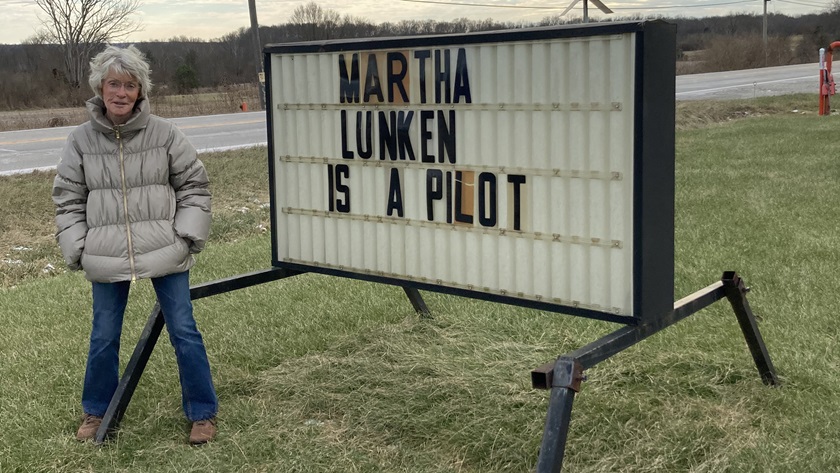Lunken advises against flying under bridges
Longtime pilot, aviation writer re-earned private certificate
Martha Lunken became a 14,000-hour private pilot on Christmas Eve, nearly 60 years after passing her first such checkride. The Ohio-based pilot and writer talked to AOPA about her aviation comeback and why she has no plans to fly under any more bridges.
Lunken took time to chat on January 12 as she worked on finishing a forthcoming column for Flying, the magazine that has featured her writing for more than a decade. She fielded a few questions about the recent checkride that she had needed to pass to fly the Cessna 180 she has owned for three decades as pilot in command, with passengers.
Lunken's story has not changed since April, when she freely admitted guilt and having knowingly violated FAR 91.119, which makes flying under a bridge unambiguously illegal.
Lunken was less forthright when asked if she had ever flown under a bridge before the flight that prompted the revocation of her certificates: "I think I have to take the Fifth there."
She said that while she believes the FAA was overly harsh, she concurs that she deserved to have her certificates suspended, and that she expected that to be the result when the FAA first advised it had opened an investigation.
"But, you know, it's a hard thing. I mean, I don't want any kid or anybody to go flying under a bridge," Lunken said, "although you'd be amazed at how many [pilots] confessed to me that they [had also done that]."
Lunken hopes others will not take her experience as an example to follow:
"I don't want to say, 'Hey, this was really cool. You guys should try this.' No, no, no, no, no. And I'm sorry it came out in public, because it might give that impression."
Lunken said the reason the FAA opted to revoke her certificates rather than suspend them for some period of time relates to another regulation and a shift in FAA enforcement policy regarding ADS-B transponder use that she did not become aware of until after the flight.
"Unbeknownst to most pilots, including me, this business of turning a transponder off, two months before I flew under a bridge, became a revocable offense," Lunken said. She reiterated her denial that she had done that, attributing the lapse in ADS-B broadcast from her aircraft's transponder to a bad connection, noting that an avionics shop that looked into the issue found the device was "loose in the mount."
"It seems that they [FAA] insist on believing that I intentionally turned off my transponder, and I did not," Lunken said. Appealing that FAA enforcement action to the NTSB would have cost Lunken at least $25,000, she said her lawyer had advised, and possibly more if the FAA appealed a decision in Lunken's favor to the full board, or beyond. "It wasn't worth it," Lunken concluded.
So, at age 79 with about 14,000 hours in her logbook and a Cessna 180 waiting for her in the hangar that she would occasionally visit while grounded, Lunken hit the books. The written tests, she noted, have become more challenging than they were in the 1960s, particularly the instrument knowledge test. In those days, she said, the FAA might not have been so strict. She imagines that local FAA staff in those days might have tucked her certificate in a desk drawer and told her to come back for it in three months.
She noted that a full year passed between her flight under the bridge and the FAA's decision to revoke her certificates on an emergency basis. "If I'm that unsafe, then why did they let me fly for a year?"
Lunken said she has hiked the trails under that bridge many times, and determined that flying under the interstate highway would not pose a risk to others.
"I knew I was not endangering anybody," Lunken said. "I expected to get a suspension and deserved a suspension. I don't think I deserved this."
Lunken has heard plenty from fellow pilots about the merits of her well-publicized case, and the FAA's approach to it. Most messages and online comments, she said, have been supportive of her view that flying under the interstate highway was harmless fun, if not, strictly speaking, legal, though about 20 percent of those who expressed a view saw it differently:
"I think one guy was a policeman in in New York, headed their aviation division, and he said, 'You should go to jail for six months for a stunt like that.'"
While rarely the subject of public discourse, the phenomenon of pilots flying intentionally under bridges was investigated by The Washington Post in 2012, in response to a reader's query about another high-profile pilot's alleged confession to flying under the 14th Street bridge in Washington, D.C.
"There is something about bridges that some pilots find irresistible," the newspaper noted, tracing the phenomenon back to 1911, when 24-year-old pilot Lincoln Beachey flew under the Falls View Bridge at Niagara Falls. It is worth noting that Beachey's penchant for airplane stunts, including flying through hangars, "eventually killed him."
Bridges can create unpredictable and unusual air disturbances and turbulence. Bridge inspectors and maintenance workers are known to rappel from the deck to inspect or work on the underside and the support structures, creating hazards, including temporary scaffolding, cables, or wires, that are difficult to spot from the air.
Lunken said she is preparing for an instrument rating checkride, though she does not plan to reapply for the many other certificates and ratings that the FAA revoked in 2021.
"I'm thrilled to be back in the air," Lunken said. "I would occasionally go down to the hangar and pet my 180 and cry a little bit … but I lived through it and all is well."




